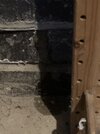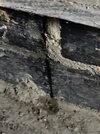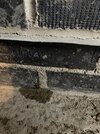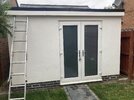Secondly the penetration and watering can test. I’ve run about 5 litres of water from a watering can without the rose into each - about 30 seconds - and taken photos from the inside. There are 3 suspect areas - one on one side and 2 close together on the other. You can see that it’s coming through the vertical joints which are clearly not right (at least I hope you can, it’s hard to get a good photo)Ok massive thanks for helping by the way. I’ve taken loads of photos and rerun the watering can test.
Firstly the roof. There was a bit of rain last night hence slightly wet. Hopefully you can see that the sides have a “lip” to prevent water run off, this is sealed with some sort of rubbery sealant. The gutter is at the back.
If you look at the fascia you can see where water has run through in one place, this is near where the water penetrates the building. It happens on the other side but you can’t see the water as well so no picture.
You are using an out of date browser. It may not display this or other websites correctly.
You should upgrade or use an alternative browser.
You should upgrade or use an alternative browser.
Leak in new brick and block building
- Thread starter pfm401
- Start date
Sponsored Links
Finally a picture of the building just in case something isn’t clear about it’s construction that matters.Secondly the penetration and watering can test. I’ve run about 5 litres of water from a watering can without the rose into each - about 30 seconds - and taken photos from the inside. There are 3 suspect areas - one on one side and 2 close together on the other. You can see that it’s coming through the vertical joints which are clearly not right (at least I hope you can, it’s hard to get a good photo)
Unfortunately I don’t have a long spirit level to check levels
Attachments
SBR in the mortar mix would have been a good idea if it was only going to be single skin, the bell cast at the bottom of the render should stop most of the water from getting to the engineering bricks. You could try stormdry masonry paint.
Your expectations are wrong.I would have expected a brick building to be watertight???
Brick walls are not water resistant unless they are designed to be. This means that walls required to resist moisture are built with a water resistant barrier which can be a a physical material lining the wall or an air gap as in a cavity wall.
What you have there is either/ both ground water or rain water wicking through that section of wall and neither of which is a defect of a solid wall.
Sponsored Links
I hear what you’re saying but I honestly thought a reasonable expectation of an outbuilding is that it would be designed not to leak water, otherwise how can you store stuff in there?Your expectations are wrong.
Brick walls are not water resistant unless they are designed to be. This means that walls required to resist moisture are built with a water resistant barrier which can be a a physical material lining the wall or an air gap as in a cavity wall.
What you have there is either/ both ground water or rain water wicking through that section of wall and neither of which is a defect of a solid wall.
Sorry I’ve made a bit of a mistake. At the sides the slab is below ground level but with gravel slightly above. At the front the slab is below ground level, I’ve just done the watering can test and water does come in.houses usually have cavity walls, and unless there is a fault or abnormal condition, rain on the outer skin will not make the inner skin damp, even if there is CWI (Cavity Wall Insulation). Solid (nine-inch walls) have less resistance, but are not usually damp unless there is a broken gutter or something making the wall wet. Either of these is an ordinary wall if built of ordinary bricks (or rendered blocks)
blue engineering bricks are impervious to water and damp should not pass through if they have been well built with strong mortar. They are considerably more expensive and would suggest a high-class job unless the builder is incompetent.
sheds and garages often have walls about four inches thick with a single leaf of brick or block. This is called "half a brick thick" because a brick is about 9 inches long. These have much less resistance to damp and water penetration. It is a cheaper build but adequate for an outbuilding. Sometimes a lining will be added later if it is to be treated as habitable space.
painted-on sealants should not be necessary. The actual fault should be found and rectified
photos would be very useful.
I don't think "sealing the edges" is right. I think it has been built wrong. Try a large spirit level side to side.
consider the possibility that your builder is an incompetent half-wit and is not capable of building a shed properly
in which case you would be better off with someone else.
Sorry I’ve made a bit of a mistake. At the sides the slab is below ground level but with gravel slightly above. At the front the slab is below ground level, I’ve just done the watering can test and water does come in.
Attachments
-
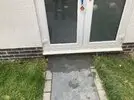 C4436A5C-2A40-489E-A79D-86E5A00EB95D.jpeg561.8 KB · Views: 84
C4436A5C-2A40-489E-A79D-86E5A00EB95D.jpeg561.8 KB · Views: 84 -
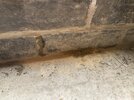 D97E9D1F-DBDC-4003-AED3-01029A569FB0.jpeg460 KB · Views: 84
D97E9D1F-DBDC-4003-AED3-01029A569FB0.jpeg460 KB · Views: 84 -
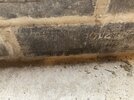 34C619AD-5806-419E-B9C2-466FD6D679FE.jpeg402.2 KB · Views: 84
34C619AD-5806-419E-B9C2-466FD6D679FE.jpeg402.2 KB · Views: 84 -
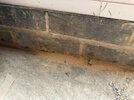 023C04AB-E808-4A75-9B9D-C374325D162E.jpeg394.9 KB · Views: 88
023C04AB-E808-4A75-9B9D-C374325D162E.jpeg394.9 KB · Views: 88 -
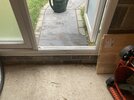 233E5E80-AC66-4955-9B5E-7F5923BD63B2.jpeg383.1 KB · Views: 87
233E5E80-AC66-4955-9B5E-7F5923BD63B2.jpeg383.1 KB · Views: 87 -
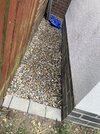 D535BA7C-6BB1-4926-8C0D-962F1237E74D.jpeg666.5 KB · Views: 96
D535BA7C-6BB1-4926-8C0D-962F1237E74D.jpeg666.5 KB · Views: 96 -
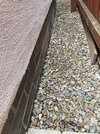 8F5664EF-2BEC-465A-91A4-624BF52C8800.jpeg639.7 KB · Views: 83
8F5664EF-2BEC-465A-91A4-624BF52C8800.jpeg639.7 KB · Views: 83
Im not really following this thread but all this talk of the roof is for what?
You build it like a house with a cavity wall or with some kind of membrane to stop the moisture getting through. Otherwise you're in the lap of the gods. If you specified to your builder from the outset that the building must be 100% watertight then you have some redress, though any builder worth their salt should have pointed out that unless you take the measures just mentioned then it cannot be guaranteed to be watertight and he should have made you aware of that, if he didn't then he's an idiot. Some water running down the outside face of the wall is a red herring that happens on every single external wall that gets rained on no matter what's it's built out of.I hear what you’re saying but I honestly thought a reasonable expectation of an outbuilding is that it would be designed not to leak water, otherwise how can you store stuff in there?
Im not really following this thread but all this talk of the roof is for what?
You build it like a house with a cavity wall or with some kind of membrane to stop the moisture getting through. Otherwise you're in the lap of the gods. If you specified to your builder from the outset that the building must be 100% watertight then you have some redress, though any builder worth their salt should have pointed out that unless you take the measures just mentioned then it cannot be guaranteed to be watertight and he should have made you aware of that, if he didn't then he's an idiot. Some water running down the outside face of the wall is a red herring that happens on every single external wall that gets rained on no matter what's it's built out of.
Cheers
I'm pretty sure we said it verbally but can't see anything on the quote. However as I've said earlier from a "customer" angle I think 95% of customers would consider it a reasonable expectation for a building to be watertight unless advised otherwise, as we simply don't have enough expertise to think otherwise (obvious exceptions including no / wrong level for DPC, anything which allows water to sit against the building etc). I've had single skin garages which have been fine.
I guess the answer is - what next? Can you retrofit a membrane or is that what the suggestion on "dry lay" concrete up the walls was? It would only be necessary along the 4 courses of engineering bricks at the bottom as the rest is rendered. Or is Storm Sure on the outside a decent answer? I'll talk through with the builder but don't want to be fobbed off with something that might last a couple of years or make things worse!
Even if I can't get the builder to take some responsibility ,if it's worth it I don't mind paying a bit extra to get something I can just forget and not worry about, at least for a few years e.g. if Storm sure needs reapplying. This is short of knocking it down and starting again, the leaks aren't serious enough for that!
The roof still needs fixing! And I'm convinced there's an issue with some of the joints because the leaks don't happen everywhere (in the areas I've tested)
Cheers
I'm pretty sure we said it verbally but can't see anything on the quote. However as I've said earlier from a "customer" angle I think 95% of customers would consider it a reasonable expectation for a building to be watertight unless advised otherwise, as we simply don't have enough expertise to think otherwise (obvious exceptions including no / wrong level for DPC, anything which allows water to sit against the building etc). I've had single skin garages which have been fine.
I guess the answer is - what next? Can you retrofit a membrane or is that what the suggestion on "dry lay" concrete up the walls was? It would only be necessary along the 4 courses of engineering bricks at the bottom as the rest is rendered. Or is Storm Sure on the outside a decent answer? I'll talk through with the builder but don't want to be fobbed off with something that might last a couple of years or make things worse!
Even if I can't get the builder to take some responsibility ,if it's worth it I don't mind paying a bit extra to get something I can just forget and not worry about, at least for a few years e.g. if Storm sure needs reapplying. This is short of knocking it down and starting again, the leaks aren't serious enough for that!
The roof still needs fixing! And I'm convinced there's an issue with some of the joints because the leaks don't happen everywhere (in the areas I've tested)
Actually the quote was to build the whole thing out of concrete blocks and render it. He did explain why he chose to use blue engineering bricks at the bottom instead but I can't remember, to be honest I just trusted his judgment (and without being qualified wouldn't have known differently). The house I grew up with was pebble dashed ie rendered to the same level, and single skin as 1920s build and I never thought anything was odd about the plan
Sorry I’ve made a bit of a mistake. At the sides the slab is below ground level but with gravel slightly above. At the front the slab is below ground level, I’ve just done the watering can test and water does come in.
Can you take a photo of the base of the wall externally with the gravel scraped away so we can see the junction between the base of the brickwork and the top of the concrete slab?
I suspect water is tracking across the top of the slab under the brickwork. That's what happens when you have the damp proof course 2 courses above the floor slab and either no damp proof membrane under the floor slab or no lap between the damp proof course and damp proof membrane.
I think the builder has tried to overcome this by using blue engineering bricks but really should have added a waterproofer in the mortar as the mortar joints will probably let the water through.
You've also saidI've said earlier from a "customer" angle I think 95% of customers would consider it a reasonable expectation for a building to be watertight
We had a “shed” built
Are the sheds from say B&Q watertight?
There's lots of threads on here about insulating sheds to keep contents dry and rust-free.
You've also said
Are the sheds from say B&Q watertight?
There's lots of threads on here about insulating sheds to keep contents dry and rust-free.
Yeah but this is a brick and block building built by a professional builder designed to last a lifetime, not something chucked together out of cheap wood with a crappy felt roof that I would expect to last 2 winters if lucky! People here have raised concerns with the builder, but up front as a consumer I would expect it to be watertight if built by a pro, and to be told if not.
I will now start diving into those threads for ideas! I guess you live and learn ....
Please see below. There seems to be a DPC at 2 and 4 courses - see internal photo. I’m sure that in at least 2 joints they’re at the vertical joints between 2nd course of bricks ie not caused by the slab. I’m not saying what you’re saying isn’t right just maybe more than one explanation.Can you take a photo of the base of the wall externally with the gravel scraped away so we can see the junction between the base of the brickwork and the top of the concrete slab?
I suspect water is tracking across the top of the slab under the brickwork. That's what happens when you have the damp proof course 2 courses above the floor slab and either no damp proof membrane under the floor slab or no lap between the damp proof course and damp proof membrane.
I think the builder has tried to overcome this by using blue engineering bricks but really should have added a waterproofer in the mortar as the mortar joints will probably let the water through.
I was told there was a DPM under the slab as I asked if I could store things on the floor. Looking at the DPC I don’t think there’s any way that it can be lapped to the membrane under the slab as the DPC is just between the brick courses.
I’m thinking of getting someone to have a look, do surveyors do this sort of thing? I worry another builder will use the immortal phrase “It’ll cost you” which it may well do but I want it to be the right thing to do!!
DIYnot Local
Staff member
If you need to find a tradesperson to get your job done, please try our local search below, or if you are doing it yourself you can find suppliers local to you.
Select the supplier or trade you require, enter your location to begin your search.
Please select a service and enter a location to continue...
Are you a trade or supplier? You can create your listing free at DIYnot Local
Sponsored Links
Similar threads
- Replies
- 1
- Views
- 184


